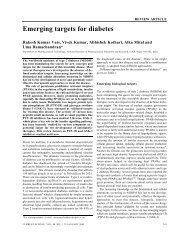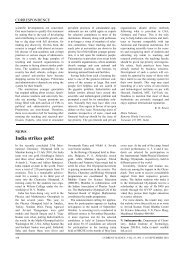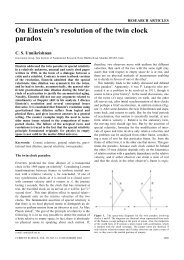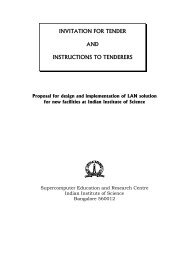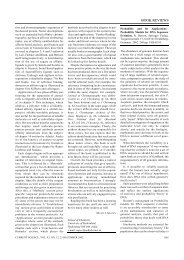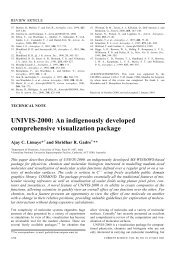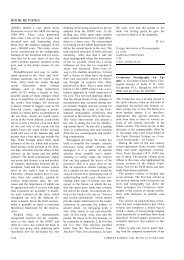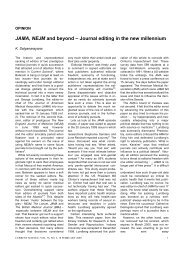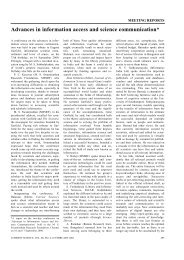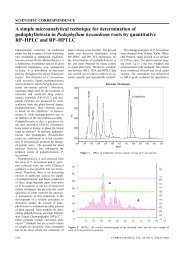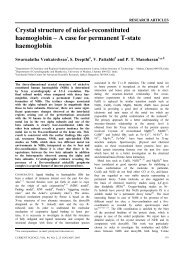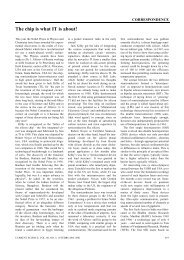Samanta's planet placing
Samanta's planet placing
Samanta's planet placing
Create successful ePaper yourself
Turn your PDF publications into a flip-book with our unique Google optimized e-Paper software.
HISTORICAL NOTES<br />
(On the solar sphere there lies the a-kar<br />
( ) inside a conch. The u-kar ( )<br />
exists inside that like the moon. The ma-kar<br />
( ) resembles the fire, blazing and<br />
dazzling. The three matras ( ), i.e.<br />
components are to be visualized as sun,<br />
moon and fire. The flame rises as lamp,<br />
above that; and that is visualized as the<br />
ardha-matra (half component) above the<br />
pranava (i.e. om-kar). That flame appears as<br />
fine as lotus fibre and measures a nadi. It<br />
is as bright as the sun; and enters deep<br />
inside seventy two thousand nadis is the<br />
measure through to the top. That (pranava)<br />
is all pervading and bestows benedictions<br />
to the material world.<br />
It is definitely an interesting picture of<br />
‘Omkar’ structure compared with the<br />
visual image of the sun, i.e. with the photosphere<br />
and the outer flame. The half<br />
mâtra ‘chandrabindu’ is visualized as the<br />
flame with the dimension of a nâdî;<br />
whereas the solar disc from bottom to the<br />
terminal is 72000 nâdîs. Samanta has<br />
definitely taken the figure from here. But<br />
there surfaces a problem of units. Nâdî in<br />
the traditional Indian system is a unit of<br />
time, which is 1/60th of a solar day. But<br />
here a nâdî is no doubt taken as a measure<br />
of length. Samanta has reckoned a nâdî<br />
as a Yojana, although we find no such<br />
mention in ancient literature.<br />
Once the linear diameter is fixed, it is<br />
easy to arrive at the distance either by the<br />
aperture projection, for which the formula<br />
is given in sloka 62–64, Ch. 19 of Siddhanta<br />
Darpana; or directly from the angular<br />
diameter of the sun, which Samanta<br />
decides to be 32′32″06″′. It is equal to<br />
72000/2213, as given by Samanta in<br />
sloka-15, Ch. 08. The figure in the denominator,<br />
i.e. 2213 comes out of the relation,<br />
θ′ = 72000 180 × 60<br />
×<br />
7608294 π<br />
72000<br />
=<br />
7608294/(180 × 60)/π = 72000<br />
2213 .<br />
The distance of the sun is given as 7608294<br />
Yojanas and θ′ is the angular diameter in<br />
min.<br />
Conversely,<br />
d =<br />
72000 × 10800<br />
.<br />
θ ′ × π<br />
The accuracy up to which the angular diameter<br />
has been given could not have<br />
been attained by measurement, with the<br />
instruments Samanta was using for the<br />
purpose. Probably, with the assumed linear<br />
diameter of 72000 Yojanas for the sun,<br />
he has determined the distance by the<br />
method of projection through the aperture.<br />
1. Aryabhata, Aryabhatiya, Critical edition<br />
by K. S. Shukla and K. V. Sarma, Indian<br />
National Science Academy, New Delhi,<br />
1976, p. 101.<br />
2. Surya Siddhanta, English translation and<br />
notes by E. Burgess (ed. Gangooly, P.),<br />
Indological Book House, New Delhi,<br />
1977, p. 295.<br />
3. Bhaskaracharya, Siddhanta Siromani,<br />
English exposition and annotation by D.<br />
Arkasomayaji, Kendriya Sanskrit Vidyapeetha,<br />
Tirupati, 1980, p. 50.<br />
4. Roy, J. C., Introduction to Siddhanta<br />
Darpana, Samanta Chandra Sekhar, Indian<br />
Depository, Calcutta, 1899.<br />
5. W. R. P., Nature, 1899, 59, 436–437.<br />
6. Naik, P. C. and Satpathy, L., Curr. Sci.,<br />
1995, 69, 705.<br />
7. Naik, P. C. and Satpathy, L., Bull.<br />
Astron. Soc. India, 1998, 36, 33–49.<br />
8. Samanta Chandra Sekhar, Siddhanta<br />
Darpana, Oriya translation by Bira Hanuman<br />
Sastri, Utkal University, 1976, p.<br />
432.<br />
9. Graner, F. and Dubralle, B., Astron. Astrophys.,<br />
1994, 282, 262–288.<br />
10. Dubralle, B. and Graner, F., Astron. Astrophys.,<br />
1994, 282, 269–276.<br />
11. Pandit Jagadish Shashtri, Upanishatsamgraha,<br />
Motilal Banarasidass Publishers,<br />
1970, (1998–Reprint), p. 292.<br />
ACKNOWLEDGEMENT. I thank Sri S. K.<br />
Vidyalankar, Department of Sanskrit, Dharanidhar<br />
Autonomous College, Keonjhar, for<br />
help in tracing the clue on diameter of the sun<br />
in Brahmavidyopanishad.<br />
Prahallad Chandra Naik is in the Department<br />
of Physics, Dharanidhar Autonomous<br />
College, Keonjhar 758 001, India.<br />
e-mail: prahalladchandra@yahoo.com<br />
Edited and published by P. Balaram, Current Science Association, Bangalore 560 080.<br />
Typeset by WINTECS Typesetters (Ph: 2332 7311), Bangalore 560 021 and Printed at Lotus Printers, Bangalore (Ph: 2320 9909)<br />
214<br />
CURRENT SCIENCE, VOL. 89, NO. 1, 10 JULY 2005



